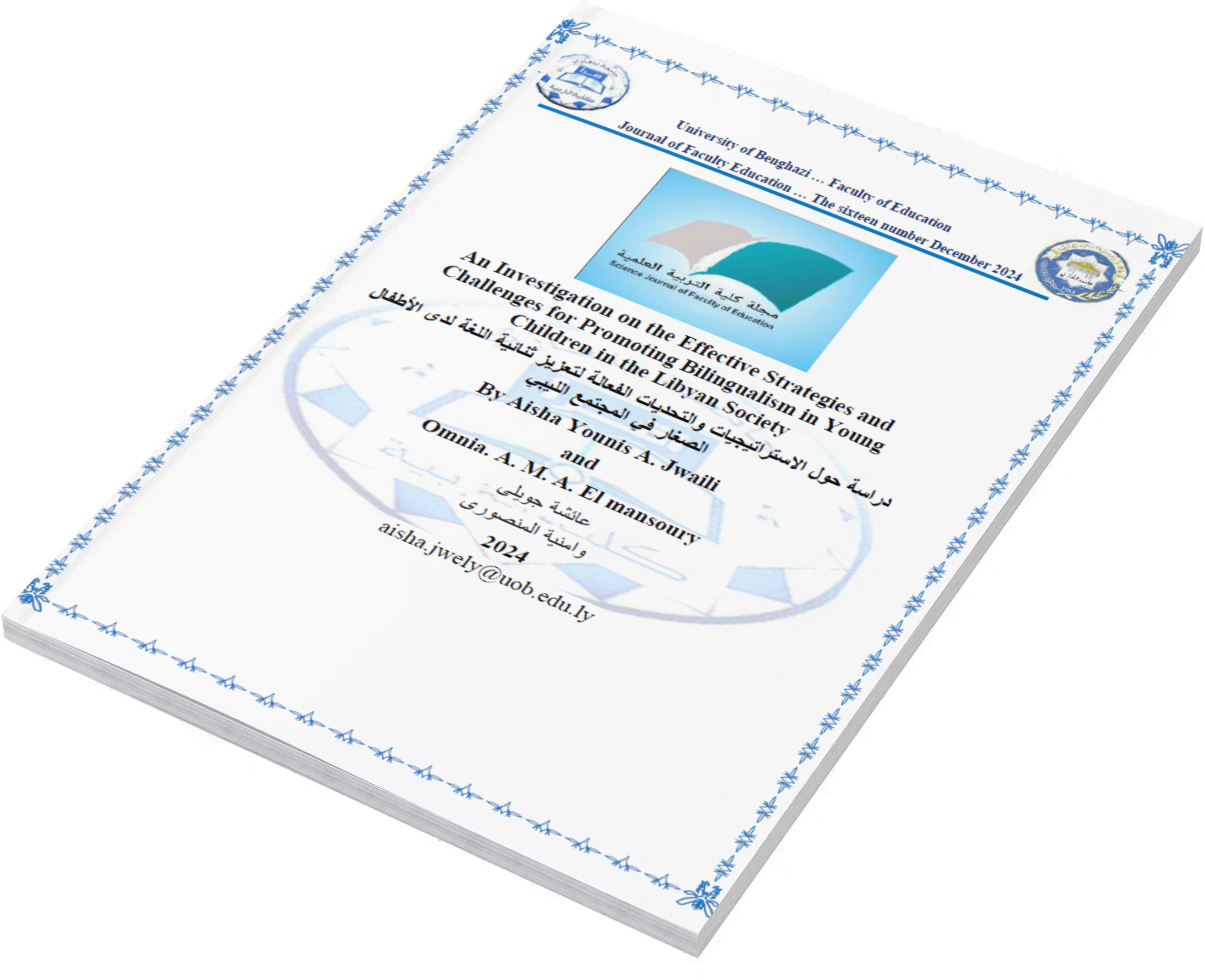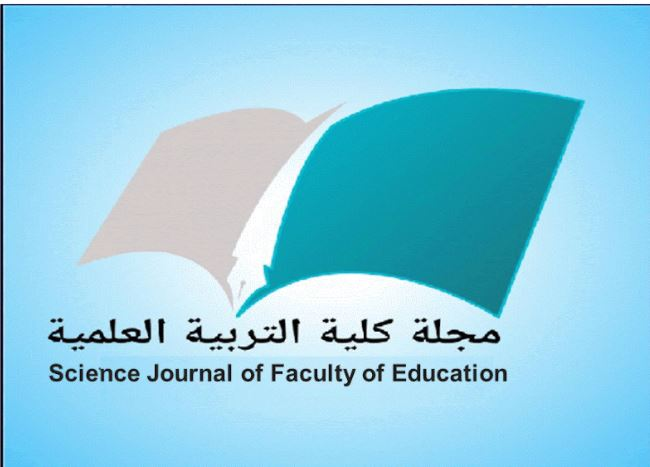دراسة حول الاستراتيجيات والتحديات الفعالة لتعزيز ثنائية اللغة لدى الأطفال الصغار في المجتمع الليبي
DOI:
https://doi.org/10.37376/fesj.vi16.7109الكلمات المفتاحية:
English as a foreign language (EFL)، Language Learning، Language Acquisition، Bilingualismالملخص
يتمتع الأطفال بطبيعة الحال بالقدرة والاستعداد لاكتساب لغات متعددة خلال سنوات تكوينهم، مما يُظهر اهتمامًا كبيرًا باكتساب اللغة. وهذا مصدر قلق كبير ودافع لبعض الآباء ليصبح أطفالهم ثنائيي اللغة. تلعب عوامل مختلفة، بما في ذلك عمر الطفل والتعرض للغات مختلفة والتفاعلات الاجتماعية، أدوارًا حاسمة في تشكيل مهاراتهم اللغوية. كشفت هذه الدراسة عن استراتيجيات وتحديات مختلفة. يمكن أن تكون الاستراتيجيات عبارة عن جهود الوالدين ومساعدة المدرسة أيضًا. تتمثل التحديات في العثور على مدرسة جيدة لتعليم الأطفال والعوامل المالية والمستهلكة للوقت.
التنزيلات
المراجع
Akhtar, N., & Menjivar, J. A. (2012). Cognitive and linguistic correlates of early exposure to more than one language. Advances in child development and behavior, 42, 41–78. https://doi.org/10.1016/b978-0-12-394388-0.00002-2
Aldosari A, Alsultan M (2017) The influence of early bilingual education
(English) on the first language (Arabic) literacy skills in the second grade
of elementary school: Saudi Arabia. J Educ Prac 8:135–142. IISTE
Baker, C. (1995). A Parents' and Teachers' Guide to Bilingualism. Multilingual Matters.
Bialystok, E., & Senman, L. (2004). Executive processes in appearance–reality tasks: The role of inhibition of attention and symbolic representation. Child development, 75(2), 562-579. https://doi.org/10.1111/j.1467-8624.2004.00693.x
Bialystok, E., Craik, F. I., & Luk, G. (2012). Bilingualism: Consequences for mind and brain. Trends in cognitive sciences, 16(4), 240–250. https://doi.org/10.1016/j.tics.2012.03.001
Byers-Heinlein, K., & Lew-Williams, C. (2013). Bilingualism in the early years: What the science says. LEARNing landscapes, 7(1), 95–112. http://dx.doi.org/10.36510/learnland.v7i1.632
Chen S, Zhao J, de Ruiter L, Zhou J, Huang J (2020) A burden or a boost:
The impact of early childhood English learning experience on lower
elementary English and Chinese achievement. Int J Bilingual Educ Bilingualism 1–18
Curdt-Christiansen, X. L. (2009). Invisible and visible language planning: Ideological factors in the family language policy of Chinese immigrant families in Quebec. Language Policy, 8(4), 351–375. https://doi.org/10.1007/s10993-009-9146-7
David, A. (2004). The developing bilingual lexicon [Unpublished doctoral dissertation]. Newcastle University.
De Mejía, A. (2002). Power, prestige, and bilingualism: International perspectives on elite bilingual education. Multilingual Matters. https://doi.org/10.21832/9781853595929
Garcia, O. (1997). Bilingual education. In F. Coulmas (Ed.), The Handbook of sociolinguistics (pp. 405-420). Blackwell Publishers Ltd.
Goetz, P. J. (2003). The effects of bilingualism on theory of mind development. Bilingualism: Language and Cognition, 6(1), 1–15. doi: 10.1017/S1366728903001007
Hussien AM (2014) The effect of learning english (L2) on learning of
Arabic literacy (L1) in the primary school. Int Educ Stud 7:88–98. Canadian
Center of Science and Education
Hornberger, N. H. (1989). Continua of Biliteracy. Review of Educational Research, 59(3), 271-296. https://doi.org/10.3102/00346543059003271
Jaumont, F. (2017). The bilingual revolution: The future of education is in two languages. TBR Books.
Koppel, R. H., & Storm, B. C. (2014). Escaping mental fixation: Incubation and inhibition in creative problem solving. Memory, 22(4), 340–348. https://doi.org/10.1080/09658211.2013.789914
Kovács, Á. M. (2009). Early bilingualism enhances mechanisms of false-belief reasoning. Developmental Science, 12(1), 48–54. DOI:10.1111/j.1467-7687.2008.00742.x
Lee, M., Shetgiri, R., Barina, A., Tillitski, J., & Flores, G. (2015). Raising Bilingual Children: A Qualitative Study of Parental Attitudes, Beliefs, and Intended Behaviors. Hispanic journal of behavioral sciences, 37(4), 503–521. https://doi.org/10.1177/0739986315602669
López, M. E. G. (2023). Family language policies of non-native bilingual parents raising bilingual children in monolingual contexts. Elia, 23, 51-85.
Moser, A., & Korstjens, I. (2017). Series: Practical guidance to qualitative research. Part 1: Introduction. European Journal of General Practice, 23(1):271-273. https://doi.org/10.1080/13814788.2017.1375093
Seo, Y. (2022). Bilingual myths and challenges of bilingual parenting as nonnative English speakers. Asia Pacific Education Review, 23, 489–499. https://doi.org/10.1007/s12564-022-09772-7
Szramek-Karcz, S. (2014). Non-native bilingualism in Poland—A formulation of the problem. Linguistica Silesiana, 35, 293–303.
Tabors, P. O. (1997). One child, two languages: A guide for preschool educators of children learning English as a second language. Paul. H. Brookes Publishing Company.
Valdés, G. & Figueroa, R. (1994). Bilingualism and testing: A special case of bias. Ablex Publishing Corporation.
Yamamoto, M. (2001). Language use in interlingual families: A Japanese–English sociolinguistic study. Multilingual Matters. https://doi.org/10.21832/9781853595417

التنزيلات
منشور
كيفية الاقتباس
إصدار
القسم
الرخصة
الحقوق الفكرية (c) 2024 مجلة كلية التربية العلمية

هذا العمل مرخص بموجب Creative Commons Attribution-NonCommercial-NoDerivatives 4.0 International License.














